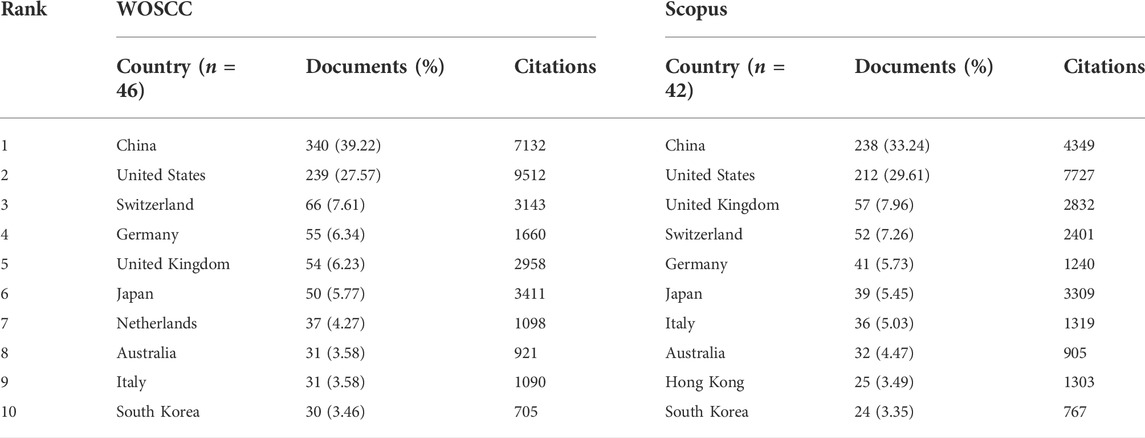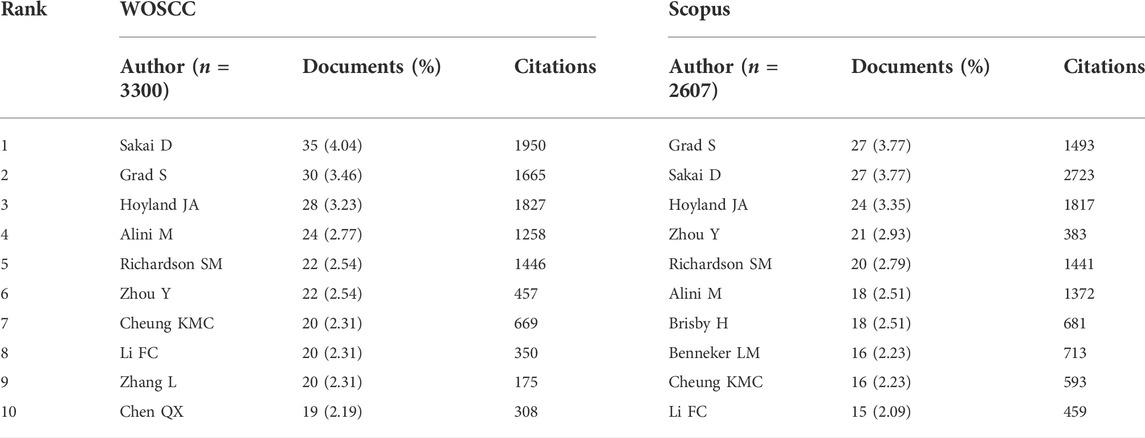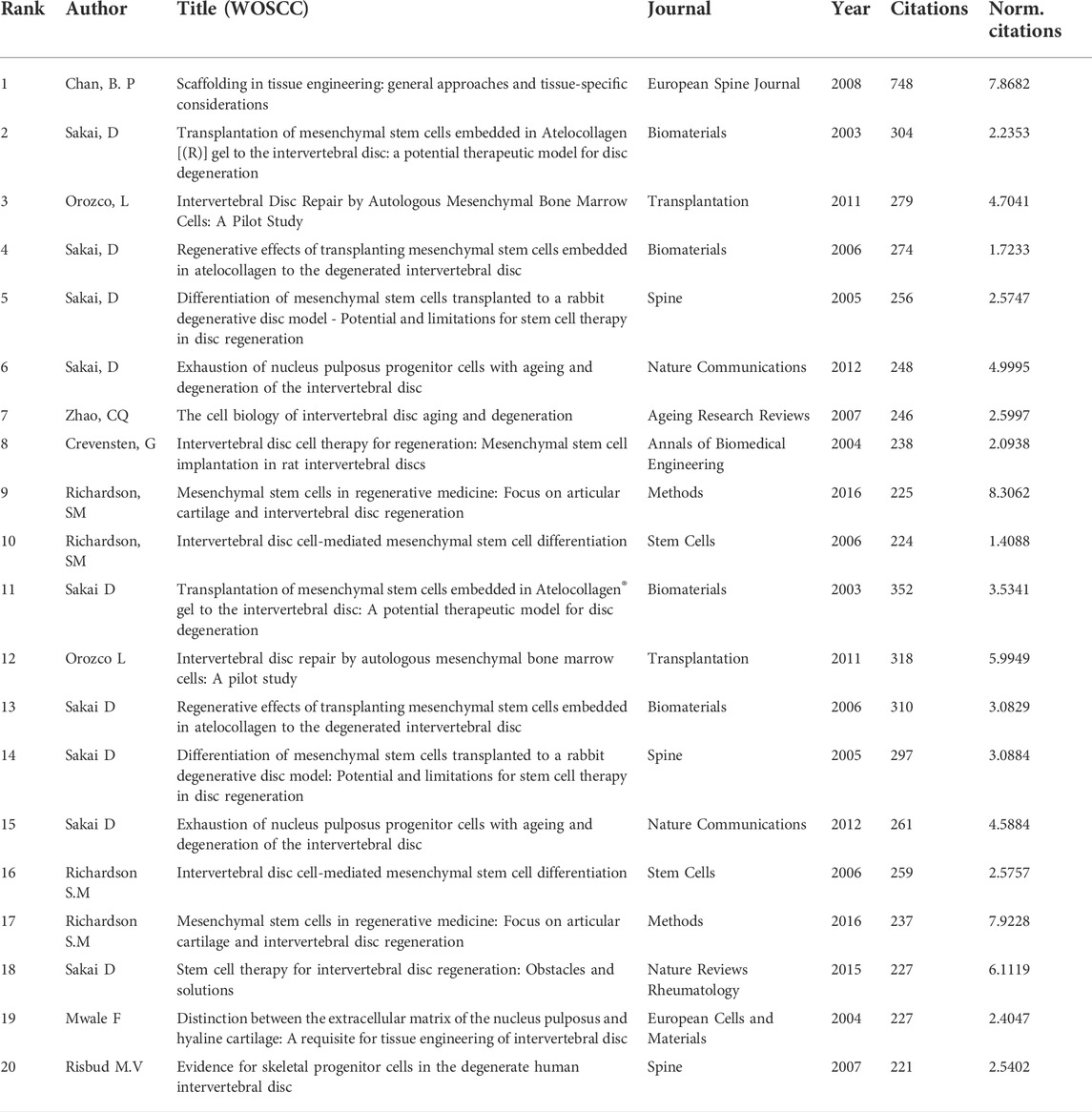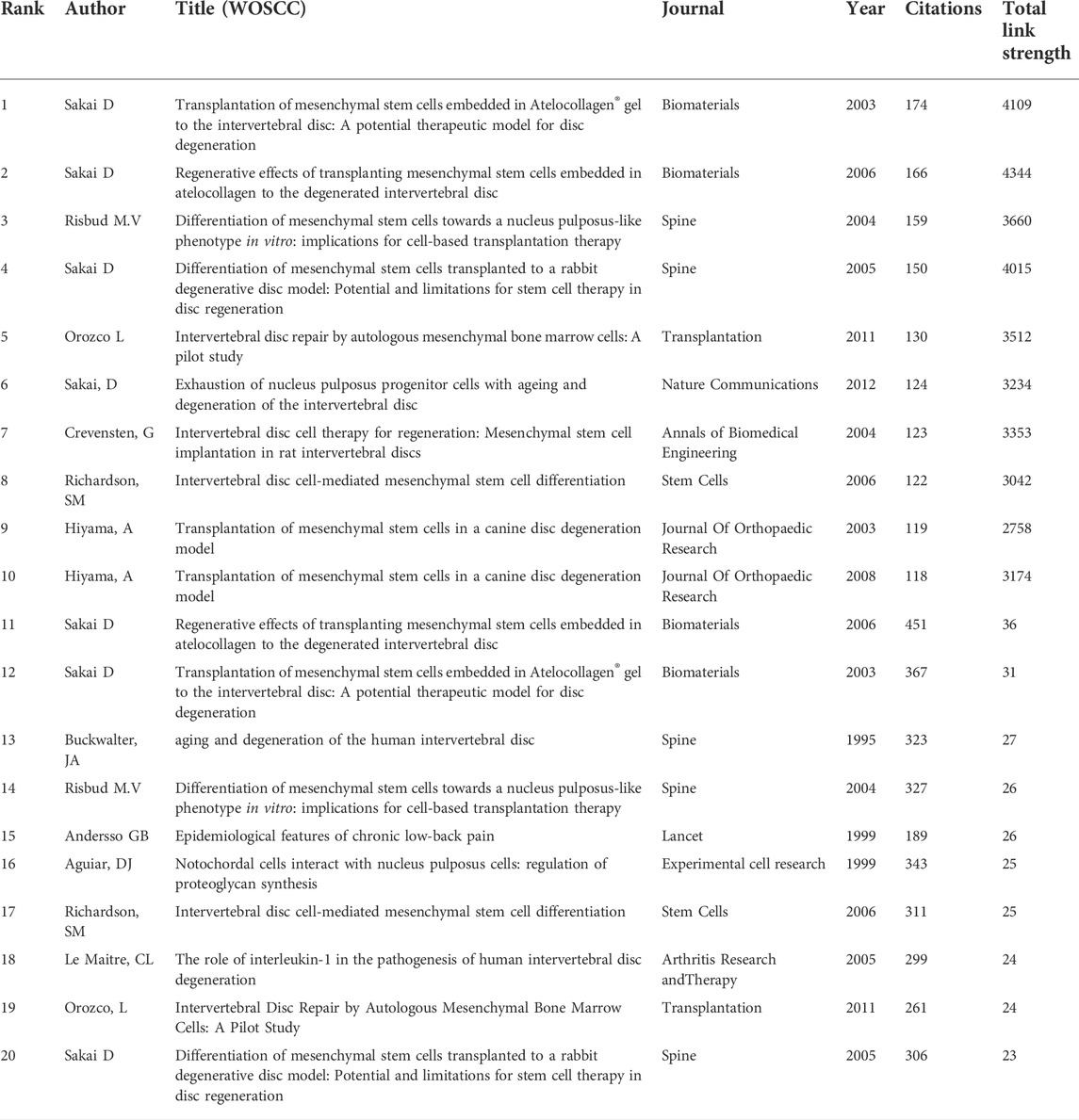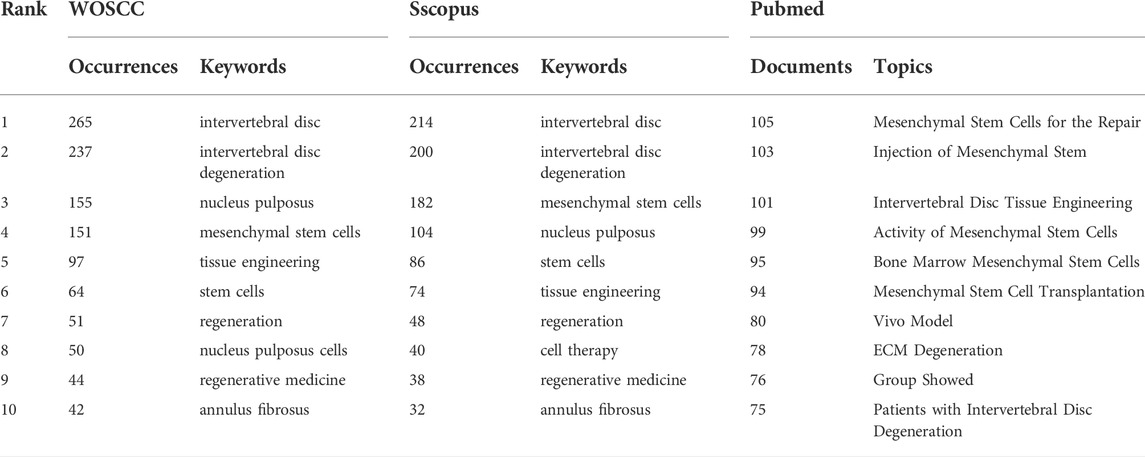- Department of Spine Surgery, Affiliated Hospital of Integrated Traditional Chinese and Western Medicine, Nanjing University of Chinese Medicine, Nanjing, China
Background: Stem cells (SCs) therapy for intervertebral disc degeneration (IDD) has been studied for nearly 20 years and it is an important part of regenerative medicine and tissue engineering research, as well as a current research hotspot and challenge. Although the volume of literature has shown an annual growth trend, there is no literature available for bibliometric and clinical analysis of the content of multiple databases in this field.
Methods: The articles were obtained from the WOSCC, Scopus, Pubmed, and ClinicalTrials on 27 December 2021. Three scientometric software (VOSviewer 1.6.17, CiteSpace 5.8.R.1 and Scimago Graphica) were used to perform bibliometric and knowledge-map analysis.
Results: We included 867 articles from WOSCC, 716 articles from Scopus and 6 clinical studies from ClinicalTrials for literature analysis. Our results showed that China was the country with the highest number of publications, with the United States (US) being the leader in terms of international collaborations and the number of citations. Sakai D, Grad S and Hoyland JA had made outstanding contributions for their high productivity and the quality articles. Spine was the most published and most cited journal, in addition to Spine Journal and Biomaterials, which were also more authoritative journals and had received high citations. All of them had received high citations. Keyword co-occurrence studies suggested that the current hotspots were in mechanistic studies, including inflammation, apoptosis, exosome, autophagy, and others. Some studies had also investigated tissue-engineered scaffolds of SCs to better repair degenerated discs. Clinical studies were relatively scarce. Direct injection of Mesenchymal Stem Cells (MSCs) into degenerated discs for the treatment of Degenerative disc disease (DDD) was the current direction of research.
Conclusion: This study demonstrates the global research hotspots, trends and clinical use of SCs in the treatment of IDD. It can help scholars to quickly understand the current status and hotspots of research in this field, and also provide some guidance and reference for those who are currently researching in this area.
Introduction
Intervertebral disc degeneration (IDD) is a chronic degenerative disease that causes an imbalance in the internal environment of the disc and affects the overall mobility of the spine (Risbud and Shapiro, 2014). It is widely recognised that IDD is a primary source of low back pain (LBP), and in severe cases causes disability (Cheung et al., 2009; de Schepper et al., 2010). It imposes a great financial load on individuals, households and even upon society (Luoma et al., 2000). The treatment of LBP is currently divided into conservative and surgical treatments (Chen et al., 2016). Unfortunately, these treatments provide partial relief but not address the underlying pathology of IDD. However, the rise of cellular therapy in recent years has made disc repair and regeneration possible (Harfe, 2022). Various studies have shown that Stem Cells (SCs) can target degenerated discs in a variety of ways, making them a particularly attractive treatment option, but the exact mechanisms are still being investigated (Hohaus et al., 2008; Krut et al., 2021).
Bibliometrics is a tool that statistical and mathematical methods are used to evaluate trends and hotspots in the field of published literature and studies (Ozsoy and Demir, 2018). Different from traditional citation statistics, it can account for links between documents and recognize knowledge structures and rising trends (Wang et al., 2021). Because of its distinctive advantages, it has become especially important in evaluating hotspots in literature and developing further projects (Chen et al., 2020). This study provides a systematic summary of the research on SCs in IDD, looking for its research frontiers, hotspots and trends, and reviewing the characteristics of clinical trials, summarising their development process and visualising them, which can provide a reference for further research in the future.
Materials and methods
Data sources and search strategies
The bibliometric search was conducted in the Web of science, Scopus and Pubmed database on 27 December 2021. The search strategy can be seen in Figure 1. In the Web of Science core collection (WOSCC) and Scopus databases, the publication type was limited to “article” and “review” and the language was restricted to English. In the Pubmed database, there was no restriction on the search results, since it is mainly used to verify keywords. Topic words were obtained from PubMed’s MESH. Using the Scopus database as an example, the search strategy was shown below: (TITLE-ABS-KEY (stem AND cells) AND TITLE-ABS-KEY (intervertebral AND disc AND degeneration)) AND (LIMIT-TO (DOCTYPE, “ar”) OR LIMIT-TO (DOCTYPE, “re”)) AND (LIMIT-TO ( LANGUAGE, “English”)).
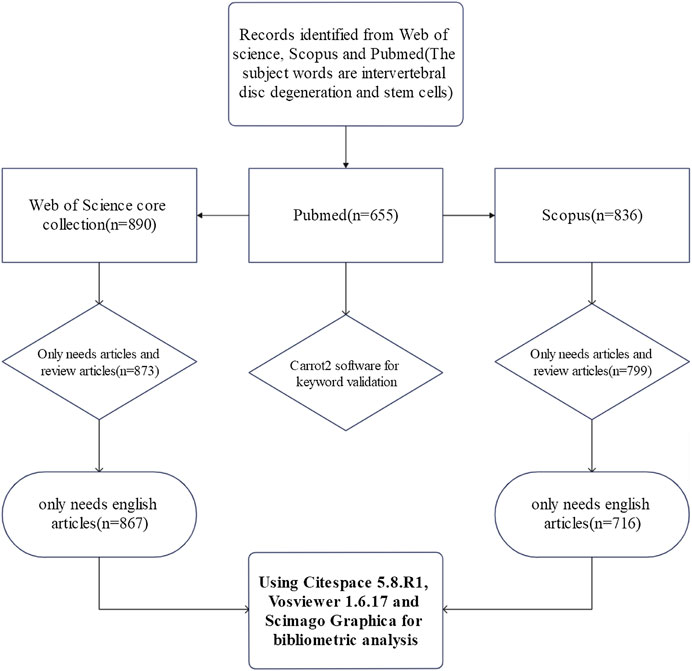
FIGURE 1. The flow chart of search strategy about SCs therapy for IDD. Full search completed on 27 December 2021. 890 articles were searched from WOSCC and 836 studies were identified from Scopus. We only needed reviews and original articles and chose English as the language type. Eventually, 867 articles in WOSCC and 716 articles in Scopus were included in the analysis.
Data collection
In the WOSCC, the results of the search were downloaded as “Full Record and Cited References” and the file format was “Plain Text” and “Windows UTF-8.” The former was processed and imported into bibliometric software for further analysis, while the latter was uploaded directly to the network for online analysis. In the Scopus, the files in “CSV” format were downloaded for subsequent analysis. The Carrot2 provided direct access to the clustering results for keywords in Pubmed (Fang et al., 2020), which allowed for some validation of the results from the previous 2 databases.
Statistical analysis and visualization software
The WOSCC and Scopus databases included its own analysis function for authors, affiliations, countries, publication titles and year of publication. The downloaded data was imported into Microsoft Excel 2016 for statistical analysis. We adopted VOSviewer 1.6.17, CiteSpace 5.8.R.1 and Scimago Graphica to recognize the network maps of journals, authors, countries/regions, institutions, cited references, co-cited references and keywords. In addition, Citespace was used to depict dual-map overlays of journals and identify keywords with a strong burst strength for exploring emerging topics. The mapping of the world was done through an online website (http://lert.co.nz/map/).
Clinical study analysis
The ClinicalTrials.gov website (https://www.clinicaltrials.gov/) was used to search for current clinical studies of SCs therapy for IDD. The disease was “Degenerative Disc Disease,” the intervention was “Stem Cells” and the status was all studies.
Results
Annual publications
The included literature was published from 2003 to 2021, of which the most was this year. As can be seen from Figure 2, there was a significant trend in global literature over time. After the first publication in 2003, this field of study gained a lot of attention from researchers. 2010–2015 saw a linear increase in the number of articles in this field. 2016–2021 saw an upward spiral, and even though 2021 is not quite over yet, it has already become the highest ever in terms of the number of articles published.
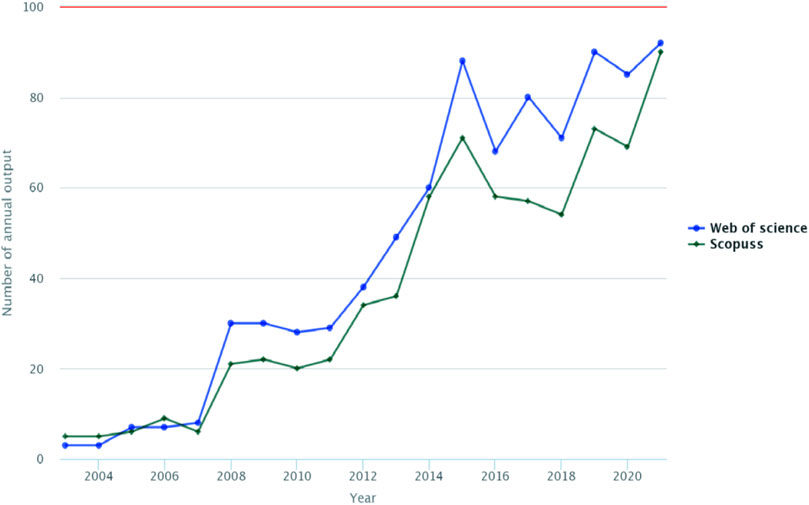
FIGURE 2. Annual publications of SCs therapy for IDD from 2003 to 2021. The trends can be split into three phases. First, 2003–2007, the initiation phase, is characterised by a slow rise; second, the rapid development phase, 2007–2015, is characterised by a continuous rise; third, the stable development phase, 2015–2021, is characterised by a circular rise. 2021 is also by far the most published year.
Country/region analysis and international cooperation
When the country/region contributions to the field were counted (Table 1), it was found that China was the most published country in both WOSCC (340) and Scopus (238), followed by the United States (239 and 212). However, in terms of citations, the US (9512 and 7727) outnumbered China (7132 and 4349), with a considerably higher average citation rate than any other country, and took first place. The top five countries in terms of publication volume were China, US, United Kingdom, Switzerland and Germany, although the order changed between the two databases (Figures 3A,C).
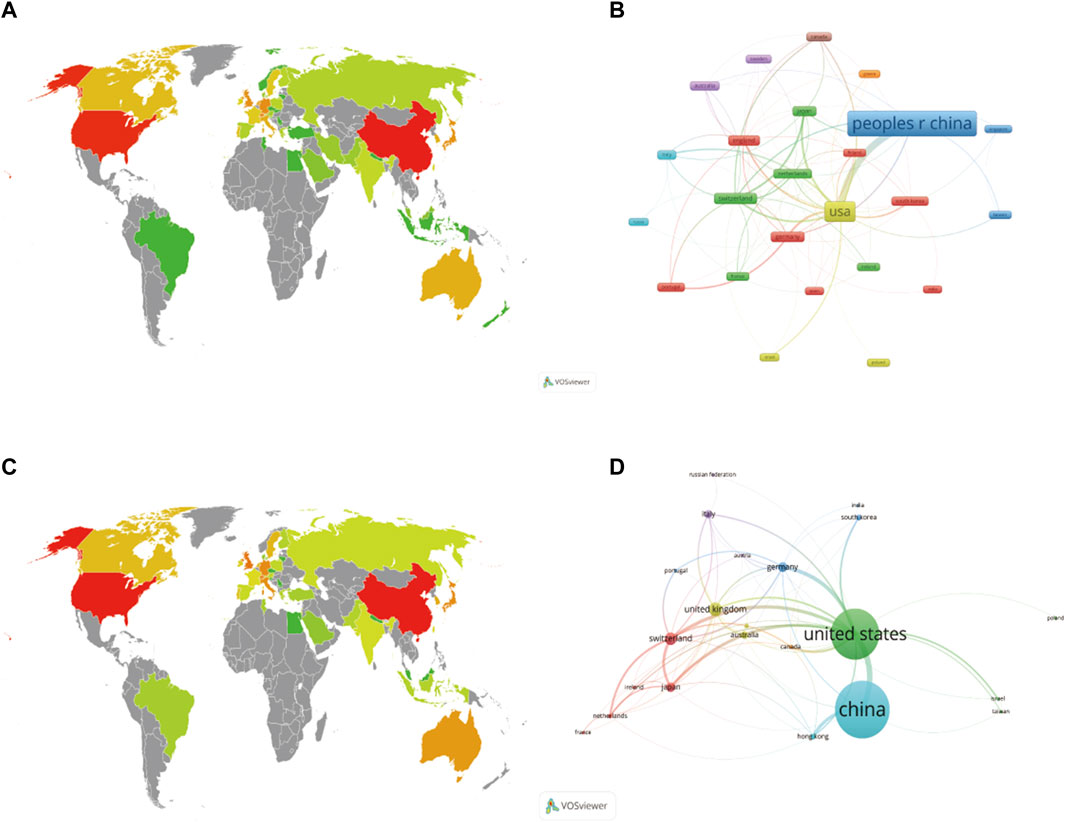
FIGURE 3. Global distribution of national publications in WOSCC (A) and Scopus (C). The darker the colour, the greater the volume of literature, with both the China and US panels in red on the world map, indicating the highest volume of publications. Cooperation networks between countries/region in WOSCC (B) and Scopus (D). Different colours represented different categories, while countries cooperated with each other by linking lines, with thicker connections implying closer cooperation. A node represented a region, with larger segments indicating more national issuance. The graph illustrated that although China has a higher volume of publications, the US cooperated more closely with other countries in international cooperation.
By using the VOSviewer to visualise cooperation between countries, different colours represent different clusters and there is close cooperation between countries in each cluster, with the active countries in the WOSCC data clustered into 8 categories and the Scopus data clustered into 7 categories. The WOSCC results showed that England, Finland, Germany, India, Portugal, South Korea and Spain were grouped in cluster 1 and there was a strong link between them. China was placed in the third cluster and the United States in the fourth (Figure 3B). However, the Scopus data showed that Switzerland, Japan, the Netherlands, Ireland and France were in cluster 1, which indicated in red, and that there were strong links between them. The United States was in cluster 2, while China was in cluster 6 (Figure 3D). The results of the country collaboration analysis using the bibliometric online analysis platform indicated that the United States played an important role in the collaboration network, followed by Switzerland, and that although China had the highest number of publications, it still lacks collaboration with other countries and needs to strengthen international exchange in the future (Figure 4).
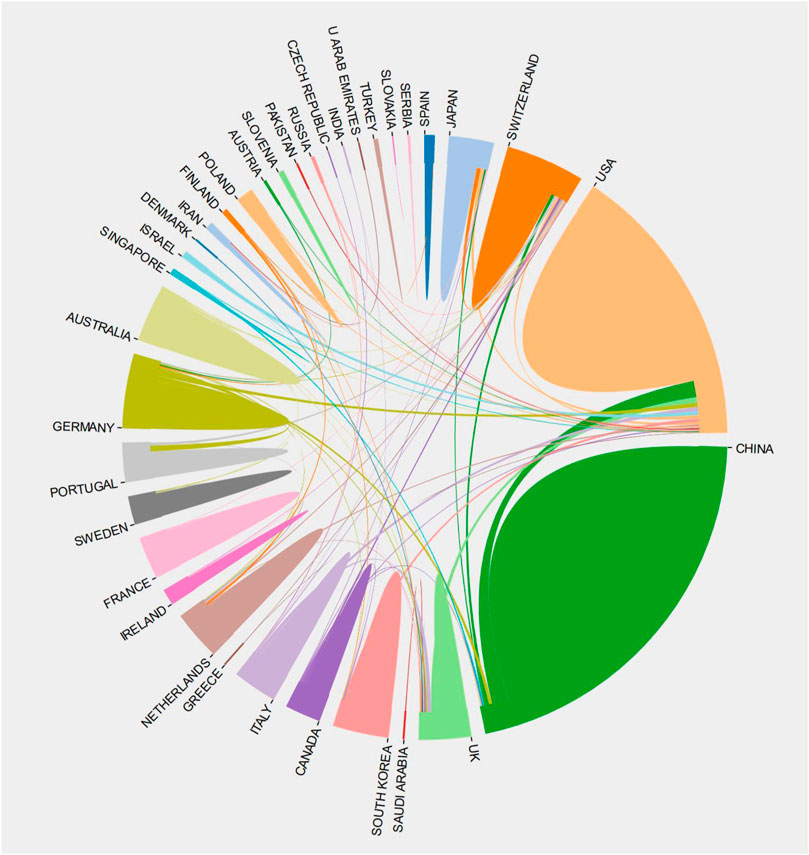
FIGURE 4. Inter-country cooperation chord chart display (take WOSCC as an example). The larger the area the greater the number of national publications, and the thicker the line the stronger the links. It can be seen that the Western countries, led by the US, were more closely linked to each other, and although China and the United States were closely linked, there was still a lack of multi-national cooperation with others.
Contributions of authors
A total of 3300 authors were found in WOSCC and 2607 in Scopus for this research area (Table 2). The three most published authors were Sakai D, Grad S and Hoyland JA, from Japan, Switzerland and the United Kingdom, respectively. In WOSCC, the top 10 authors published 27.68% of the total number, compared to 28.21% in Scopus. The most cited author was Sakai D, followed by Hoyland JA and Grad S. It was evident that these three authors had a high volume of publications with high citation rates and had a significant influential status in this field.
A visual analysis of the authors’ collaborations was performed using the VOSviewer software. In WOSCC, the important authors were divided into 9 clusters (Figure 5A). The first cluster was represented by Grad S, Alini M, Benneker lM, among others, who formed a close collaborative network with each other. And Grad S had the highest total link strength of 84, which highlighted his importance in cluster 1. Cluster 2 was represented by Mauck, Rl and others, and cluster 3 was Sakai D with others.

FIGURE 5. Cooperation networks between Authors in WOSCC (A) and Scopus (B). Different colours represented different clusters, while authors cooperated with each other by linking lines, with thicker connections implying closer cooperation. A node represented an author, with larger segments indicating more publications. In WOSCC, key authors formed 9 clusters and 11 clusters were formed from Scopus.
However, in Scopus, important authors were divided into 11 clusters (Figure 5B), each indicated by a different color. In cluster 1, Chinese scholars represented by Zhou Y and Zhang Y were interconnected and formed a complex network, mostly from China, but lacking collaboration with internationally recognized experts. Grad S had the highest total link strength with a value of 127, and he was in cluster 2. The second and third ranked authors in terms of total link strength were Wang J and Li F respectively, both of whom were in cluster 5.
Journal analysis
The results of both databases showed that Spine (IF = 3.47, Q1) and Spine journal (IF = 4.17, Q1) were the two most widely published journals in the field (Table 3). Although Spine was recognised as the most widely published journal in this research area, the most highly cited journal was Biomaterials (IF = 12.48, Q1). It was clear that Biomaterials was the more authoritative journal in the stem cell field.
The dual-map overlay of the journal showed a total of one pink primary citation path and one orange primary citation path (Figures 6A,B). The pink path represents that publications in Neurology/Sports/Ophthalmology journals cite publications in Molecular/Biology/Genetics journals. The orange path suggests that publications in Molecular/Biology/Immunology journals typically usually cite publications in Molecular/Biology/Genetics journals. The journal network graph showed that Spine had the highest total link strength in the network (WOSCC = 704, Scopus = 596), followed by Biomaterials (WOSCC = 660, Scopus = 331), indicating their important role in the field of journals (Figures 6C,D).
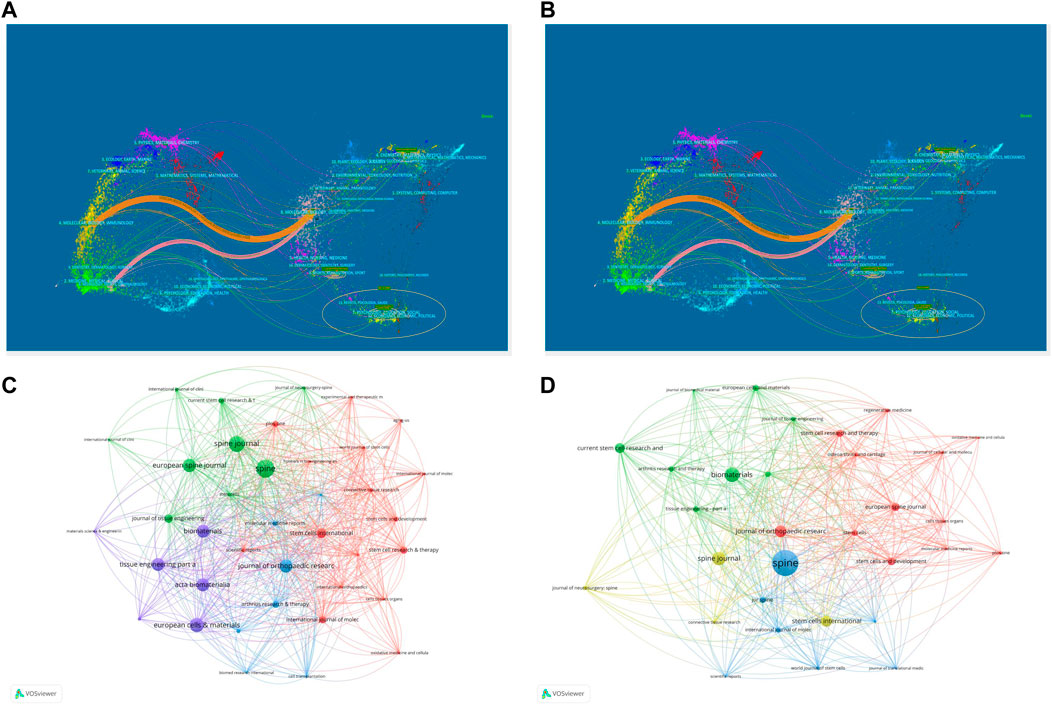
FIGURE 6. The dual-map overlay of journals in WOSCC (A) and Scopus (B). The dual-map overlay of the journal showed a total of one pink primary citation path and one orange primary citation path. The journal network graph in WOSCC (C) and Scopus (D). In WOSCC, key journals formed 4 clusters and 4 clusters were formed from Scopus.
Highly cited articles
Chan, B. P’s 2008 article in the European Spine Journal entitled “Scaffolding in tissue engineering: general approaches and tissue-specific considerations” was the most cited paper. It was a review and had a Norm. citations of 7.87. Apart from the first article in WOSCC, the top 5 highly cited articles were the same in both databases. This reinforced the importance of these articles in the field, and Sakai, D had made a significant contribution to this research area, with four of the top 6 highly cited publications in WOSCC and four of the top 5 in Scopus coming from him (Table 4). Citations are not a fully objective representation of the importance of literature, as it is influenced by duration. Norm. citations, on the other hand, exclude this interference. The high Norm. citations of an article, even if it does not have a high total number of citations, is proof of its importance. Of the two databases, a 2016 article by Richardson, SM entitled “Mesenchymal stem cells in regenerative medicine: Focus on articular cartilage and intervertebral disc regeneration” published in Methods received the highest Norm. citations. Although it was published late, it still received a lot of attention and obtained a high number of citations right after publication.
Highly cited articles were presented visually via VOSviewer software. The different points represented different documents, which formed a complex network between them. The more frequently cited documents were represented as larger points in the graph. The different colours of the dots represented different publication periods. For example, in WOSCC (Figure 7A), chan (2008) was the largest point, indicating that it was the most cited document, while its blue colour indicated that it was published earlier in the whole network. What’s more, in Scopus (Figure 7B), cheng x (2018) was the brighter point, indicating that it was published later.
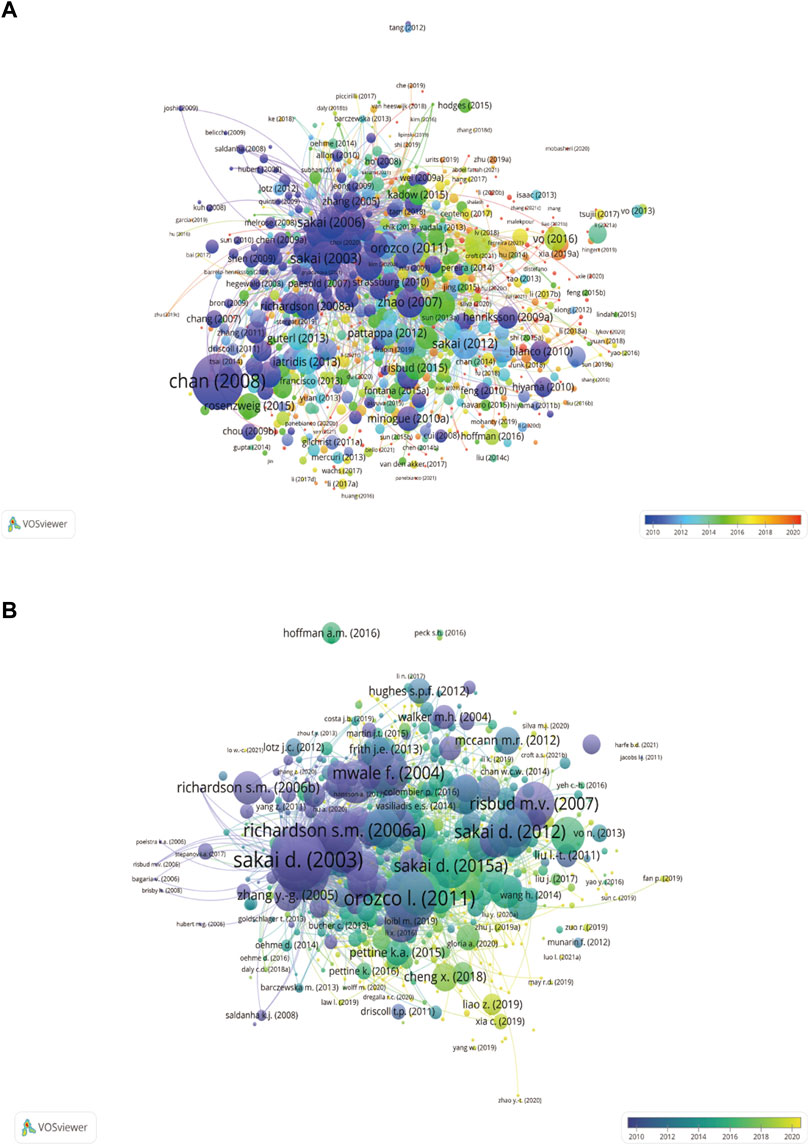
FIGURE 7. Overlay visualization plots of cited literature in WOSCC (A) and Scopus (B). The different points represented different documents, which formed a complex network between them. The more frequently cited documents were represented as larger points in the graph. The different colours of the dots represented different publication periods. For example, in WOSCC, chan (2008) was the largest point, indicating that it was the most cited document, while its blue colour indicated that it was published earlier in the whole network. What’s more, in Scopus, cheng x (2018) was the brighter point, indicating that it was published later.
Co-citation articles
The top 10 co-cited references in the WOSCC and Scopus database were shown in Table 5. A total of five of the top 10 co-citations in both databases were identical, indicating the stronger linkage of these five to research in the field. Sakai D’s 2006 article in Biomaterials, entitled “Regenerative effects of transplanting mesenchymal stem cells embedded in atelocollagen to the degenerated intervertebral disc,” had the highest total link strength in the co-citation analysis. This article deserves to be read and studied carefully.
VOSviewer was used to analyse the clustering of co-cited literature. In WOSCC (Figure 8A), the important co-cited articles were divided into five clusters. Strong links were formed between clusters within clusters. The top 4 citations were all clustered into cluster 2, while the 5th ranked literature was clustered into cluster 1. Sakai D (2003), this node had the strongest total link strength in the network, indicating its importance. And in Scopus, it was also clustered into 6 clusters (Figure 8B). The two most co-cited articles were clustered into cluster 2, which also had the highest total link strength and played an important role in the co-cited literature network.
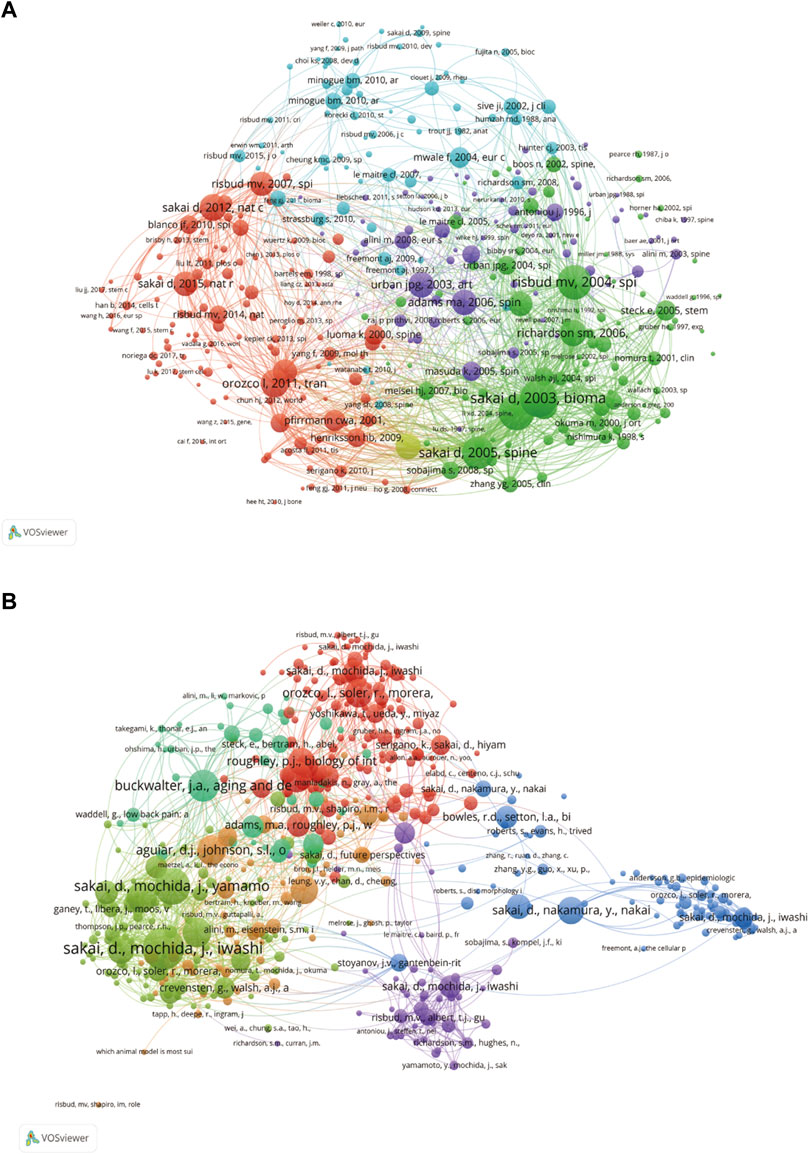
FIGURE 8. The co-citations network graph in WOSCC (A) and Scopus (B). In WOSCC, co-citations formed 5 clusters and 6 clusters were formed from Scopus. Different colours represented different clusters. The size of a node represented how many citations the document has received, the higher the number of citations the larger the node. If two nodes were connected, they were connected by lines, and the more nodes connected, the stronger the connection.
Analysis of keywords
The main keywords are listed in Table 6. As can be noticed, the top 10 keywords in terms of occurrences were mostly the same in WOSCC (Figure 9A) and Scopus (Figure 9B). They were mainly related to intervertebral disc, mesenchymal stem cells, nucleus pulposus, tissue engineering, regeneration and others. We had used Carrot2 to predict the main topics in this field, with Mesenchymal Stem Cells for the Repair appearing most frequently, followed by Injection of Mesenchymal Stem, Intervertebral Disc Tissue Engineering and Activity of Mesenchymal Stem Cells (Figures 9C–E).
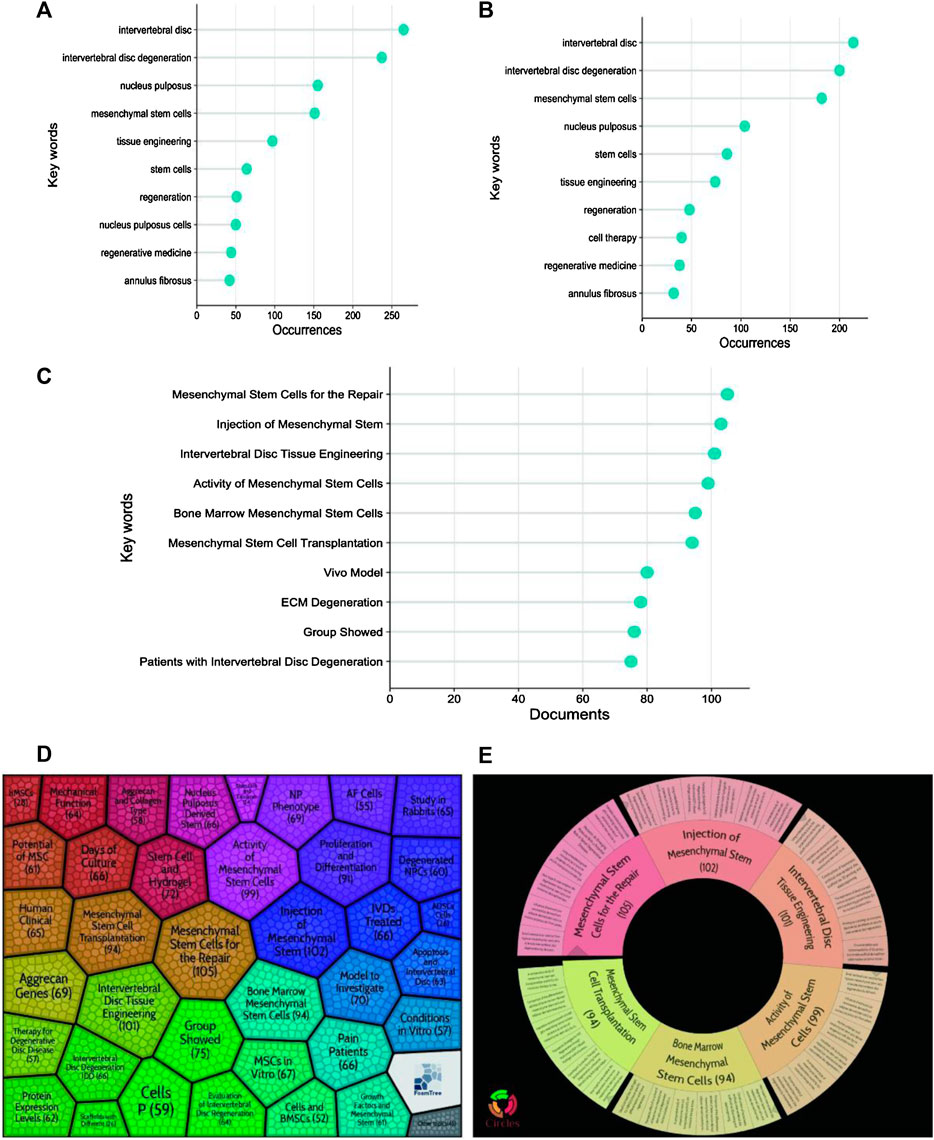
FIGURE 9. Keyword occurrence frequency statistics. (A): Top 10 keywords lollipop chart in WOSCC; (B): Top 10 keywords lollipop chart in Scoups; (C): Top 10 topics lollipop chart in Pubmed; (D): Main topics treemap using Carrot2; (E): Main topics pie-chart using Carrot2.
The keywords were clustered and analyzed by the VOSviewer software. In WOSCC, there were 94 keywords that co-occurred more than 5 times and were co-clustered into 9 categories (Figure 10A), while only 44 keywords that co-occurred more than 10 times. However, there were 79 keywords that co-occurred more than 5 times and were co-clustered into 9 categories, while only 35 keywords that co-occurred more than 10 times (Figure 10B) in Scopus. We applied Scimago Graphica to analyse keywords with a co-occurrence greater than 10 and presented them as a ring chart (Figures 10C,D). In the end, we used Citespace to analyse the strongest citation bursts for keywords to identify research hotspots and trends over time (Figures 10E,F).
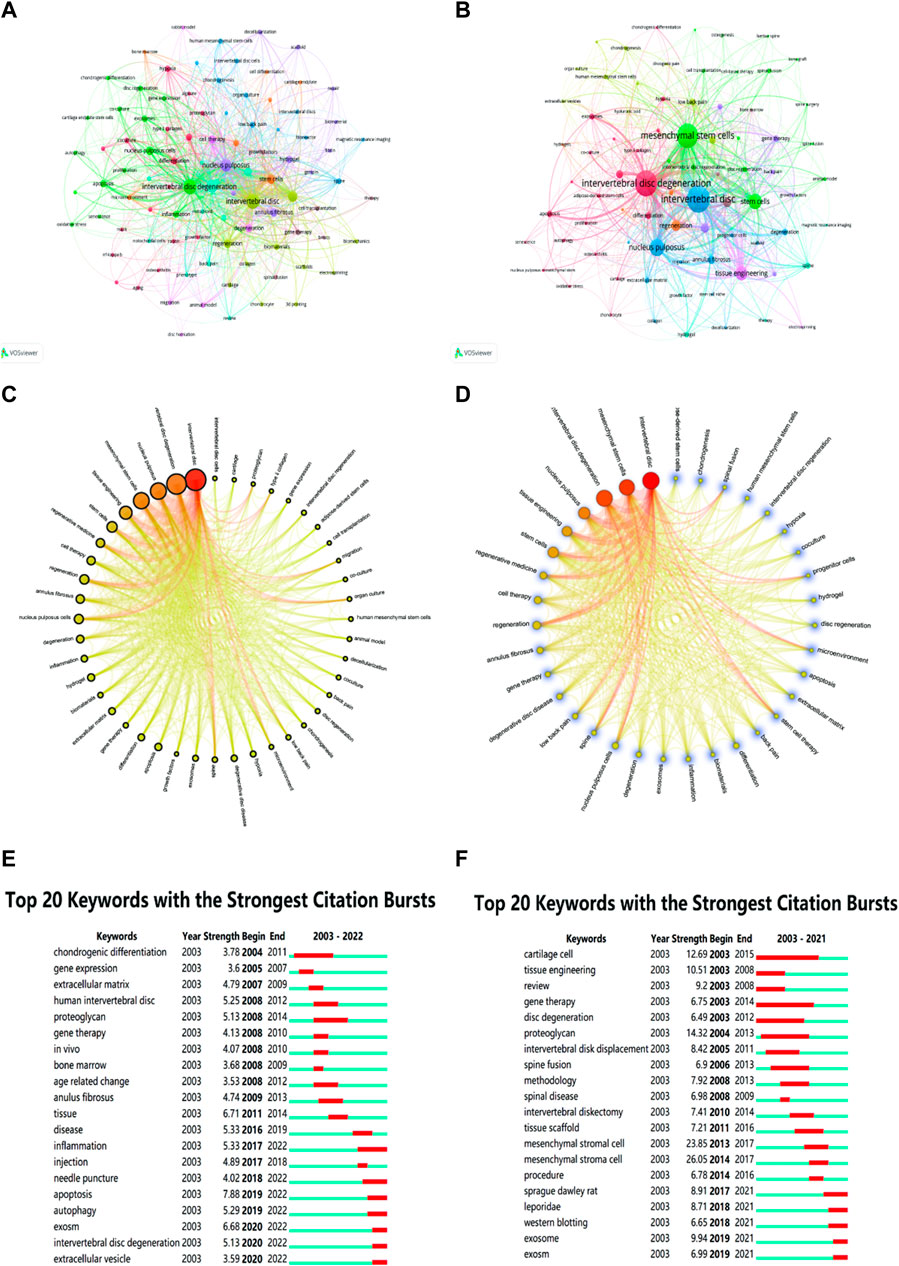
FIGURE 10. Keyword clustering, total link strength and strongest citation bursts analysis. The keywords clustering network visualization analysis in WOSCC (A) and Scopus (B). In WOSCC and Scopus, main author keywords all formed 9 clusters. The circular diagrams (C,D) were used to highlight the number of major co-occurring keywords and the total link strength. The greater the occurrence frequency, the larger the node, the higher the total link strength, the redder the segment, and the larger the link between the two, the thicker and deeper the line. The top 20 keywords with the strongest citation bursts in WOSCC (E) and Scopus (F). The color indicated the various frequent keywords (red represented frequent and green represented infrequent).
Clinical studies
A total of 36 eligible studies were retrieved based on topic terms. We only analysed studies that had been completed or were recruiting, filtered to obtain a total of 19 messages, and finally read the titles and content to include 6 studies (Supplementary Table S1). Three of these studies had been completed and others were recruiting patients. In terms of study design, there were four single group studies and three randomised controlled studies.
Discussion
Bibliometric analysis of the state of research
This article used a bibliometric approach to provide an overall assessment of the current status, hotspots and trends on the use of SCs in IDD. The results indicated that research articles had shown a year-on-year increase in recent years, suggesting that SCs were receiving increasing attention in research on the treatment of IDD. In terms of country analysis, China had the most publications, but the US had the most citations, indicating that Chinese scholars still need to enhance the quality of literature and learn from countries with higher citation rates. The analysis of the cooperative network showed that the US occupied an important position in the cooperative network and maintained close cooperation with many countries around the world, which will provide a definite boost to the development of this field. However, the total link strength of China in the cooperation network was still lacking compared with that of the US. This demonstrated that China still needs to strengthen international cooperation to promote the development of this field. The analysis of authors’ contributions showed that the international authors with high volume of publications were Sakai D, Grad S, Hoyland JA and others. It suggested that we can strengthen communication with these scholars. Although China was the first in the overall number of publications, there were fewer prominent authors, among which Zhou Y and Li FC had more publications, but the research team was still dominated by domestic collaboration and lacked international exchange. This hinted that the authors of our research still need to strengthen mutual cooperation and learn from the experience of Sakai D and other teams. The results of the journal study showed that Spine, Spine Journal, and Biomaterials were the journals to focus on in this field. They were recognized as key journals, not only for their large number of publications, but for their high citation rate. It was suggested that scholars can focus on the literature published in these journals when studying this area.
Analysis of cited literature
The first literature in this field appeared in 2003 and was published in Spine by Gruber, HE. It was a review that focused on recent advances in intervertebral disc cell biology. In his article, he mentioned the potential of SCs in the treatment of IDD (Gruber and Hanley, 2003). The first research article was published in Biomaterials by Sakai, D in 2003. He transplanted mesenchymal stem cells (MSCs) embedded in Atelocollagen gel into the intervertebral disc of a model rabbit and found it to be efficient in alleviating IDD (Sakai et al., 2003). The importance of this study is evident from the fact that it is the most cited original research literature, both in WOSCC and in Scopus. In WOSCC, Chan, B. P published a review in European Spine Journal in 2008, which reviewed the function and methods of tissue-engineered scaffolds as an example of intervertebral discs and clarified that MSC as part of tissue engineering holds significant promise in the repair of IDD (Chan and Leong, 2008). Orozco, L published a pilot study in Transplantation in 2011, which was another highly cited article. He demonstrated the feasibility and effectiveness of this method by injecting autologous bone marrow mesenchymal stem cells (BM-MSCs) into the nucleus pulposus (NP) of patients with IDD (Orozco et al., 2011). This approach may become an effective alternative therapy for LDD and is widely accepted by scholars. Richardson S.M published a review in 2016 which had the highest average annual citation. The article details SCs therapy for the repair of degenerative disc, highlighting the high promise of SCs as a form of cell therapy in IDD (Richardson et al., 2016).
Co-cited references disclosed how often two articles were cited together by other articles, and this can be seen as the basis of knowledge in a specialized area (Chen, 2006). Sakai D’s articles published in Biomaterials in 2003 and 2006 respectively received the highest total co-citation link strength and researchers can look to these two publications for lessons (Sakai et al., 2003; Sakai et al., 2006). This article addressed for the first time that MSCs can be converted to a NP phenotype and suggests that MSCs can be used to repopulate damaged or degenerated intervertebral discs (Risbud et al., 2004). It provides a more important guide to the study of tissue engineering strategies for NP regeneration. Combining the co-citation analysis of both databases, another important paper was an original study published in 2005 in Spine, who demonstrated in a rabbit model that MSCs have the potential to differentiate into NP cells (Sakai et al., 2005). There were also a number of articles published before 2003 which focused on the clinical and mechanistic aspects of IDD (Buckwalter, 1995; Aguiar et al., 1999; Andersson, 1999).
Analysis of research hotspots and research trends
Keyword co-occurrence analysis can be used to identify interests and hotspots in the field and to look for cutting-edge trends, aiding scientists to provide direction in a wide range (Zhao et al., 2021). The frequency and total link strength results in the keyword analysis indicated that MSCs were the more researched cells, with research directed mainly towards the regeneration of NP cells, which is part of tissue engineering. Using Carrot2 to analyze topic studies, the results focused on the SCs function, usage, transfer, and activity. From the above studies, it can be concluded that research was mainly divided into clinical research and mechanistic research on SCs therapy for IDD. The results of the cluster analysis of keywords also indicated that the interest of this study focused on SCs as a cell therapy for the treatment of degenerative disc disease (DDD) by regenerating NP cells. This therapy belongs to the scope of tissue engineering research. In recent years, the burst keywords have shown growing interest, which is a major indicator of the forefront trends in the sector (Wang et al., 2021).
Early research SCs therapy for IDD was associated with chondrogenic differentiation (Steck et al., 2005; Richardson et al., 2006), affecting gene expression (Vadala et al., 2008), and others. This was followed by a series of mechanistic studies to demonstrate how SCs differentiate into myeloid cells (Lu et al., 2008; Stoyanov et al., 2011) and tissue engineering scaffolding studies (Calderon et al., 2010). In recent years, there have been a number of hot topics and trends focusing on inflammation (Zhao et al., 2020; Ekram et al., 2021), apoptosis (Nan et al., 2020b; Hu et al., 2021), autophagy (Nan et al., 2020a; He et al., 2021), and exosome (Hu et al., 2021; Krut et al., 2021). However, there is no single mechanism for SCs treatment of IDD, and multiple mechanisms are often intertwined, which requires an overall grasp and further exploration.
Clinical study analysis
ClinicalTrials.gov, as a database offered by the US National Library of Medicine, contains a collection of reference clinical trials conducted around the world on a variety of conditions and diseases (Rechberger et al., 2021). We have used the clinicalTrials website as a basis for some analysis of clinical studies. Only 6 of the registered clinical observational studies were eligible, showing that although a large amount of basic research has been conducted on SCs therapy for IDD, clinical studies are still relatively small at present and further randomised controlled studies (RCT) are needed at a later stage to improve the level of evidence. The current clinical use of SCs in the treatment of IDD is mainly by direct injection into the degenerated disc of the patient. From the clinical trials that have been screened and registered, the main types of SCs used are Human Umbilical Cord Mesenchymal Stem Cells (HUC-MSCs), BM-MSCs and Adipose Stem Cells. BM-MSCs are the most widely used. This suggests that our later clinical studies may also focus on assessing the efficacy and safety of BM-MSCs injected into degenerated discs in patients with DDD.
Strengths and limitations
This study is the first relatively systematic bibliometric and visual analysis for SCs in IDD and provides some insight for scholars studying this field. But it still has some limitations. Although this article searched WOSCC, Scopus and Pubmed and conducted some analysis, it was independent and did not sufficiently incorporate the data. The study only included articles whose language was English, ignoring non-English articles, and only original studies and reviews were included, all of which resulted in the analysis not being fully comprehensive. The database is updated in real time, which leads to the possibility that our results may differ from those available at the time of publication. Fewer studies were included for clinical studies and there were no complete conclusions. Therefore, it remains important to keep abreast of the latest and neglected literature to gain a comprehensive understanding of current hotspots and future trends, while further research is needed in clinical research methods to clarify efficacy.
Conclusion
This study demonstrates the global research hotspots, trends and clinical use of SCs in the treatment of IDD. Annual publication trends in this study are increasing, with China being the most published country and the US being the largest contributor, both of whom are ahead of the curve in this field. Sakai D, Grad S and Hoyland JA have made outstanding contributions and are recognized by other scholars for their high productivity and the quality of their research. Spine is the most published and most cited journal, in addition to Spine Journal and Biomaterials, which are also more authoritative journals and have received high citations. All of them have received high citations. Keyword co-occurrence studies suggest that the current hotspots are in mechanistic studies, including inflammation, apoptosis, exosome, and autophagy. Some studies have also investigated tissue-engineered scaffolds of SCs to better repair degenerated discs. Clinical studies are relatively scarce. Direct injection of MSCs into degenerated discs for the treatment of DDD is the current direction of research, but large, multicentre clinical studies are still needed to demonstrate the efficacy, and safety of this method.
Data availability statement
The raw data supporting the conclusions of this article will be made available by the authors, without undue reservation.
Author contributions
Correspondence to LX. NW is the first author. LX and NW contributed to the concept and design of the study. NW, SC, and XZ contributed to retrieve and analyze data. ZX and CX used software to draw pictures. NW, XF and JL wrote and revised the manuscript. All authors were fully involved in the study and preparation of the manuscript.
Funding
The current research was funded by Jiangsu Provincial Traditional Chinese Medicine Science and Technology Development Plan Project (2020 ZD202008), the Foundation for leading talent in traditional Chinese medicine of Jiangsu province (2018 SLJ0210), Science and technology projects in Jiangsu Province (2019 BE2019765), and Natural Science Foundation of JiangsuProvince (BK 20221420).
Acknowledgments
We are particularly grateful to Professor Ran Kang, Department of Spine Surgery, Affiliated Hospital of Integrated Traditional Chinese and Western Medicine, Nanjing University of Chinese Medicine for his guidance on the method and writing of this article.
Conflict of interest
The authors declare that the research was conducted in the absence of any commercial or financial relationships that could be construed as a potential conflict of interest.
Publisher’s note
All claims expressed in this article are solely those of the authors and do not necessarily represent those of their affiliated organizations, or those of the publisher, the editors and the reviewers. Any product that may be evaluated in this article, or claim that may be made by its manufacturer, is not guaranteed or endorsed by the publisher.
Supplementary Material
The Supplementary Material for this article can be found online at: https://www.frontiersin.org/articles/10.3389/fphar.2022.873177/full#supplementary-material
References
Aguiar, D. J., Johnson, S. L., and Oegema, T. R. (1999). Notochordal cells interact with nucleus pulposus cells: Regulation of proteoglycan synthesis. Exp. Cell Res. 246 (1), 129–137. doi:10.1006/excr.1998.4287
Andersson, G. B. (1999). Epidemiological features of chronic low-back pain. Lancet (London, Engl. 354 (9178), 581–585. doi:10.1016/s0140-6736(99)01312-4
Buckwalter, J. A. (1995). Aging and degeneration of the human intervertebral disc. Spine 20 (11), 1307–1314. doi:10.1097/00007632-199506000-00022
Calderon, L., Collin, E., Velasco-Bayon, D., Murphy, M., O'Halloran, D., Pandit, A., et al. (2010). Type II collagen-hyaluronan hydrogel - a step towards a scaffold for intervertebral disc tissue engineering. Eur. Cell. Mat. 20, 134–148. doi:10.22203/ecm.v020a12
Chan, B. P., and Leong, K. W. (2008). Scaffolding in tissue engineering: General approaches and tissue-specific considerations. Eur. Spine J. 17, S467–S479. doi:10.1007/s00586-008-0745-3
Chen, C., Lou, Y., Li, X. Y., Lv, Z. T., Zhang, L. Q., Mao, W., et al. (2020). Mapping current research and identifying hotspots on mesenchymal stem cells in cardiovascular disease. Stem Cell Res. Ther. 11 (1), 498. doi:10.1186/s13287-020-02009-7
Chen, C. M. (2006). CiteSpace II: Detecting and visualizing emerging trends and transient patterns in scientific literature. J. Am. Soc. Inf. Sci. Technol. 57 (3), 359–377. doi:10.1002/asi.20317
Chen, X. F., Zhu, L. X., Wu, G. F., Liang, Z. H., Yang, L. L., Du, Z. C., et al. (2016). A comparison between nucleus pulposus-derived stem cell transplantation and nucleus pulposus cell transplantation for the treatment of intervertebral disc degeneration in a rabbit model. Int. J. Surg. 28, 77–82. doi:10.1016/j.ijsu.2016.02.045
Cheung, K. M. C., Karppinen, J., Chan, D., Ho, D. W. H., Song, Y. Q., Sham, P., et al. (2009). Prevalence and pattern of lumbar magnetic resonance imaging changes in a population study of one thousand forty-three individuals. Spine 34 (9), 934–940. doi:10.1097/BRS.0b013e3181a01b3f
de Schepper, E. I. T., Damen, J., van Meurs, J. B. J., Ginai, A. Z., Popham, M., Hofman, A., et al. (2010). The association between lumbar disc degeneration and low back pain the influence of age, gender, and individual radiographic features. Spine 35 (5), 531–536. doi:10.1097/BRS.0b013e3181aa5b33
Ekram, S., Khalid, S., Bashir, I., Salim, A., and Khan, I. (2021). Human umbilical cord-derived mesenchymal stem cells and their chondroprogenitor derivatives reduced pain and inflammation signaling and promote regeneration in a rat intervertebral disc degeneration model. Mol. Cell. Biochem. 476 (8), 3191–3205. doi:10.1007/s11010-021-04155-9
Fang, J., Pan, L., Gu, Q. X., Juengpanich, S., Zheng, J. H., Tong, C. H., et al. (2020). Scientometric analysis of mTOR signaling pathway in liver disease. Ann. Transl. Med. 8 (4), 93. doi:10.21037/atm.2019.12.110
Gruber, H. E., and Hanley, E. N. (2003). Recent advances in disc cell biology. Spine 28 (2), 186–193. doi:10.1097/00007632-200301150-00017
Harfe, B. D. (2022). Intervertebral disc repair and regeneration: Insights from the notochord. Semin. Cell Dev. Biol. 127, 3–9. doi:10.1016/j.semcdb.2021.11.012
He, R. J., Wang, Z., Cui, M., Liu, S., Wu, W., Chen, M., et al. (2021). HIF1A Alleviates compression-induced apoptosis of nucleus pulposus derived stem cells via upregulating autophagy. Autophagy 17 (11), 3338–3360. doi:10.1080/15548627.2021.1872227
Hohaus, C., Ganey, T. M., Minkus, Y., and Meisel, H. J. (2008). Cell transplantation in lumbar spine disc degeneration disease. Eur. Spine J. 17, S492–S503. doi:10.1007/s00586-008-0750-6
Hu, Y. Q., Tao, R. Y., Wang, L. F., Chen, L., Lin, Z., Panayi, A. C., et al. (2021). Exosomes derived from bone mesenchymal stem cells alleviate compression-induced nucleus pulposus cell apoptosis by inhibiting oxidative stress. Oxidative Med. Cell. Longev. 2021, 1–12. doi:10.1155/2021/2310025
Krut, Z., Pelled, G., Gazit, D., and Gazit, Z. (2021). Stem cells and exosomes: New therapies for intervertebral disc degeneration. Cells 10 (9), 2241. doi:10.3390/cells10092241
Lu, Z. F., Zandieh Doulabi, B., Wuisman, P. I., Bank, R. A., and Helder, M. N. (2008). Influence of collagen type II and nucleus pulposus cells on aggregation and differentiation of adipose tissue-derived stem cells. J. Cell. Mol. Med. 12 (6B), 2812–2822. doi:10.1111/j.1582-4934.2008.00278.x
Luoma, K., Riihimaki, H., Luukkonen, R., Raininko, R., Viikari-Juntura, E., and Lamminen, A. (2000). Low back pain in relation to lumbar disc degeneration. Spine 25 (4), 487–492. doi:10.1097/00007632-200002150-00016
Nan, L. P., Wang, F., Liu, Y., Wu, Z., Feng, X. M., Liu, J. J., et al. (2020a). 6-gingerol protects nucleus pulposus-derived mesenchymal stem cells from oxidative injury by activating autophagy. World J. Stem Cells 12 (12), 1603–1622. doi:10.4252/wjsc.v12.i12.1603
Nan, L. P., Wang, F., Ran, D., Zhou, S. F., Liu, Y., Zhang, Z., et al. (2020b). Naringin alleviates H2O2-induced apoptosis via the PI3K/Akt pathway in rat nucleus pulposus-derived mesenchymal stem cells. Connect. Tissue Res. 61 (6), 554–567. doi:10.1080/03008207.2019.1631299
Orozco, L., Soler, R., Morera, C., Alberca, M., Sanchez, A., Garcia-Sancho, J., et al. (2011). Intervertebral disc repair by autologous mesenchymal bone marrow cells: A pilot study. Transplantation 92 (7), 822–828. doi:10.1097/TP.0b013e3182298a15
Ozsoy, Z., and Demir, E. (2018). Which bariatric procedure is the most popular in the world? A bibliometric comparison. Obes. Surg. 28 (8), 2339–2352. doi:10.1007/s11695-018-3163-6
Rechberger, J. S., Thiele, F., and Daniels, D. J. (2021). Status quo and trends of intra-arterial therapy for brain tumors: A bibliometric and clinical trials analysis. Pharmaceutics 13 (11), 1885. doi:10.3390/pharmaceutics13111885
Richardson, S. M., Curran, J. M., Chen, R., Vaughan-Thomas, A., Hunt, J. A., Freemont, A. J., et al. (2006). The differentiation of bone marrow mesenchymal stem cells into chondrocyte-like cells on poly-L-lactic acid (PLLA) scaffolds. Biomaterials 27 (22), 4069–4078. doi:10.1016/j.biomaterials.2006.03.017
Richardson, S. M., Kalamegam, G., Pushparaj, P. N., Matta, C., Memic, A., Khademhosseini, A., et al. (2016). Mesenchymal stem cells in regenerative medicine: Focus on articular cartilage and intervertebral disc regeneration. Methods 99, 69–80. doi:10.1016/j.ymeth.2015.09.015
Risbud, M. V., Albert, T. J., Guttapalli, A., Vresilovic, E. J., Hillibrand, A. S., Vaccaro, A. R., et al. (2004). Differentiation of mesenchymal stem cells towards a nucleus pulposus-like phenotype in vitro: Implications for cell-based transplantation therapy. Spine 29 (23), 2627–2632. doi:10.1097/01.brs.0000146462.92171.7f
Risbud, M. V., and Shapiro, I. M. (2014). Role of cytokines in intervertebral disc degeneration: Pain and disc content. Nat. Rev. Rheumatol. 10 (1), 44–56. doi:10.1038/nrrheum.2013.160
Steck, E., Bertram, H., Abel, R., Chen, B. H., Winter, A., Richter, W., et al. (2005). Induction of intervertebral disc-like cells from adult mesenchymal stem cells. Stem Cells 23 (3), 403–411. doi:10.1634/stemcells.2004-0107
Sakai, D., Mochida, J., Iwashina, T., Hiyama, A., Omi, H., Imai, M., et al. (2006). Regenerative effects of transplanting mesenchymal stem cells embedded in atelocollagen to the degenerated intervertebral disc. Biomaterials 27 (3), 335–345. doi:10.1016/j.biomaterials.2005.06.038
Sakai, D., Mochida, J., Iwashina, T., Watanabe, T., Nakai, T., Ando, K., et al. (2005). Differentiation of mesenchymal stem cells transplanted to a rabbit degenerative disc model - potential and limitations for stem cell therapy in disc regeneration. Spine 30 (21), 2379–2387. doi:10.1097/01.brs.0000184365.28481.e3
Sakai, D., Mochida, J., Yamamoto, Y., Nomura, T., Okuma, M., Nishimura, K., et al. (2003). Transplantation of mesenchymal stem cells embedded in atelocollagen gel to the intervertebral disc: A potential therapeutic model for disc degeneration. Biomaterials 24 (20), 3531–3541. doi:10.1016/s0142-9612(03)00222-9
Stoyanov, J. V., Gantenbein-Ritter, B., Bertolo, A., Aebli, N., Baur, M., Alini, M., et al. (2011). Role of hypoxia and growth and differentiation factor-5 on differentiation of human mesenchymal stem cells towards intervertebral nucleus pulposus-like cells. Eur. Cell. Mat. 21, 533–547. doi:10.22203/eCM.v021a40
Vadala, G., Studer, R. K., Sowa, G., Spiezia, F., Lucu, C., Denaro, V., et al. (2008). Coculture of bone marrow mesenchymal stem cells and nucleus pulposus cells modulate gene expression profile without cell fusion. Spine 33 (8), 870–876. doi:10.1097/BRS.0b013e31816b4619
Wang, Y. Z., Wu, C. C., and Wang, X. Q. (2021). Bibliometric study of pain after spinal cord injury. Neural Plast. 2021, 15. doi:10.1155/2021/6634644
Zhao, H., Liu, J. B., Bao, Z. F., Xu, Y. X., and Wang, Z. Q. (2021). Global research trends in dental stem cells: A bibliometric and visualized study. Tissue Eng. Part B Rev. doi:10.1089/ten.teb.2021.0080
Keywords: bibliometrics, intervertebral disc degeneration, stem cells, visualization research, treatment
Citation: Wang N, Chen S, Zhang X, Xi Z, Fang X, Xue C, Li J and Xie L (2022) Global research status and hot trends in stem cells therapy for Intervertebral disc degeneration: A bibliometric and clinical study analysis. Front. Pharmacol. 13:873177. doi: 10.3389/fphar.2022.873177
Received: 10 February 2022; Accepted: 12 July 2022;
Published: 08 August 2022.
Edited by:
Peter Natesan Pushparaj, King Abdulaziz University, Saudi ArabiaReviewed by:
Nguyen Minh Duc, Pham Ngoc Thach University of Medicine, VietnamJafar Rezaie, Urmia University of Medical Sciences, Iran
Copyright © 2022 Wang, Chen, Zhang, Xi, Fang, Xue, Li and Xie. This is an open-access article distributed under the terms of the Creative Commons Attribution License (CC BY). The use, distribution or reproduction in other forums is permitted, provided the original author(s) and the copyright owner(s) are credited and that the original publication in this journal is cited, in accordance with accepted academic practice. No use, distribution or reproduction is permitted which does not comply with these terms.
*Correspondence: Lin Xie, eGllbGluQG5qdWNtLmVkdS5jbg==
 Nan Wang
Nan Wang Shuang Chen
Shuang Chen Jingchi Li
Jingchi Li